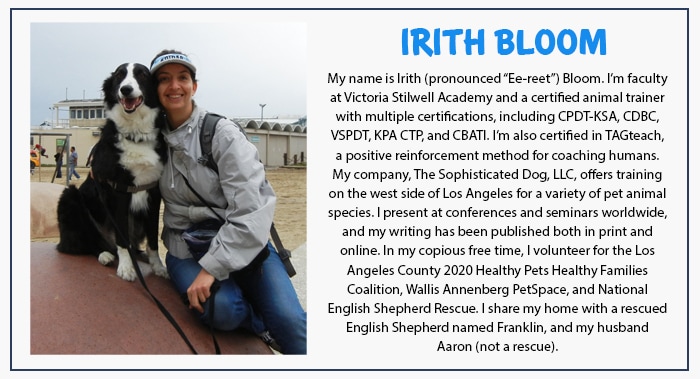Contributed by Irith Bloom, faculty at Victoria Stilwell Academy and certified animal trainer with multiple certifications, including CPDT-KSA, CDBC, VSPDT, KPA CTP, and CBATI.
How to Encourage Dog Obedience With Clicker Training
One of the fastest and easiest ways to train an animal to do a behavior on cue is to capture the behavior. “Capturing” is one of the basic methods used in clicker training to teach dog behavior. I use capturing all the time to train people’s pets to do common behaviors. It’s pretty straightforward, and often very efficient. In fact, my clients can sometimes capture a simple behavior such as sit or down in a single training session.
This clicker training technique is called “capturing” because you use it to capture, or “grab hold of” behaviors that the animal already does naturally. If you are looking to train a brand new behavior that the animal has never done or you want to change the way a behavior looks, capturing is not the right tool. On the other hand, capturing is a great tool for teaching a cat to meow on cue, or a rabbit to “binky” on cue. If your pet is already doing the behavior, you can probably capture it.
To capture a dog behavior, you need to have a clicker, such as the Downtown Pet Supply Training Dog Clicker, along with food, such as American Journey Salmon Recipe Grain-Free Oven Baked Dog Treats. If you use a pouch such as the Starmark Pro-Training Treat Pouch for Dogs, you can have treats on hand without having to run to the cabinet.
While you can capture a wide range of behaviors and use capturing with many different kinds of pets, this article will focus on how to train a dog to sit on cue using capturing. “Sit” is a basic obedience training behavior that can be used to keep your dog still while he’s waiting for his food, for example. “Sit” can also give your dog something to do to earn petting, instead of jumping up on people, as discussed in Positively Trained: How to Train Your Dog Not to Jump on Guests.
How to Train a Dog to Sit With Clicker Training
So you want to capture “Sit.” Where do you start? First of all, make sure you are carrying a clicker (here’s another one you can try: Starmark Pro-Training Clicker Deluxe Dog Training Aid) and treats (such as Blue Buffalo Wilderness Trail Treats Turkey Recipe) with you at all times. As mentioned above, a treat pouch such as the Tuff Mutt Treat Pouch can help you get to the treats quickly when you see the right dog behavior.
Then, watch your dog carefully to see if he happens to sit. As soon as he does, click and then reward him with treats. If you hold the treat just out of reach, he has to stand up from the sit position to get the treat, which sets him up to sit again. Then you can watch and wait again.
Continue to click and treat every time your dog does the behavior. Over time, you will start to notice that your dog is sitting more often. You may also see an expectant look on his face after he sits. Once your dog is repeating the behavior in an obviously deliberate way, stand in a single place and click and treat for sits repeatedly. If your dog does five or six sits in a row within about 30 seconds, he’s probably figured out that sitting earns clicks and treats.
Now that your dog is offering the behavior repeatedly, it’s time to give the behavior a name. This is the point in clicker training where we add the cue. To do this, first wait until you are sure that your dog is about to do the behavior, and then say the cue just before the behavior starts. Then click and treat when your dog does the right thing. Since we are working on “sit,” the sequence would be as follows:
- Dog’s body language shows that the dog is about to sit.
- You say “Sit.”
- Dog sits. (Note: This is just a coincidence at first, due to your excellent cue timing).
- You click and offer a treat (away from your dog, so he has to get up to eat the treat).
After a few sessions where you say the cue when you know your dog is about to sit, you can try the cue when he isn’t about to sit. Wait until your dog is just going about his ordinary business and not even thinking about you, and then say “Sit” and see what happens. If your pup sits after hearing the cue, click and then offer him a treat.
If your dog doesn’t sit when you say the cue, that means you need to do more repetitions where you get your dog into a rhythm and say “Sit” at the right time. Don’t fret if this is the case! Dogs can take anywhere from three repetitions to dozens of repetitions of a new cue before they make the association between cue and behavior, especially if this is the first cue they’ve ever learned.
Now that you’ve used capturing to teach your dog to sit on cue, you can try using capturing for other dog obedience behaviors, such as lying down on cue. You can also use it for fun behaviors your dog does occasionally that you’d like to get on cue, such as barking (“Speak!”) or scratching (“Did you see a flea?”). And don’t forget that capturing can be used with any natural behavior that any species of pet does. When it comes to capturing, the sky’s the limit!

Share:















